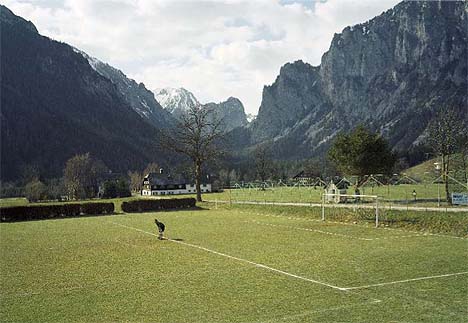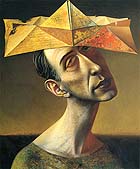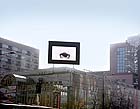
translated and summarized by: Liz Wollner-Grandville,
English summaries June 16 - 30
Camera Austria: Hans van der Meer – Work and play
The man and his doing
Camera Austria is showing a carefully chosen retrospective of works by the Dutch photographer and artist Hans van der Meer, the majority of whose works depict photos on or about football.
Van der Meer mainly creates series, usually setting out from one single photograph. His well-known football series show this clearly. In one of them the match-scenario concentrates on the keeper, standing somewhat lonely in front his goal, anticipating a manoeuvre by the opposing team. Van der Meer also emphasizes the surrounding landscape, which is definitely part of the motif, but never dwindles into a kitschy cliché.
In addition to the photographs, videos, and publications about football, works showing his craftsmanship and the process behind his creations are also displayed – a series created by van der Meer between 1991 and 1993. In “Quirk of Fate” (1986), created in Budapest, the artist focuses his attention on human beings. Capturing and portraying body language is an essential element of van der Meer’s work. His remarkable power of observation is at all times convincing – be it in his series on football, on people or on animals. The photos develop out of the artist’s sensitive, humorous view – the twinkle in his eye being omnipresent.
Camera Austria
8020 Graz, Kunsthaus Graz, Lendkai 1, until 31.08.2008
www.camera-austria.at
Guggenheim Museum Bilbao: Surreal Things
Matters of super-reality
This gigantic show includes surreal designer objects, costumes, furniture, architecture, jewellery, fashion, film, and advertisements. Only the best works - the 250 most important objects, paintings, and sculptures, such as Dali’s Lobster Phone, Man Ray’s Cadeau (iron with nails) or Joan Miro’s and Giorgio de Chirico’s costumes, are displayed in Bilbao until September 7. No efforts or money were spared to pay homage to this exceptional art movement, many of whose representatives had close ties with Peggy Guggenheim. The objects are presented in elaborate and stage like rooms, over dimensional showcases and pedestals, with theatrical curtains, fabulously lit and transposed into a super-reality adequate to surrealism.
The show was put together in 2007 by the Victoria & Albert Museum, curated by Ghislaine Wood and thematically displayed in seven large rooms in Bilbao.
Stage settings, costumes, and designs including Miro’s “Romeo and Julia” and “Jeux d’enfants”, Giorgio di Chirico’s costumes for “Le Bal” (1929) and André Masson’s “Sketch for the Finale” are effectively positioned and complemented with photos and films of the performances. Vases and sculptures by Hans Arp in context with Calder’s mobile, organic lamps, settees with stools by Isamo Noguchi (1948) and photos by Man Ray, Herbert Bayer and Eileen Agar are displayed and for the first time the complete “Model of the Surrealistic Museum” (1942) is shown.
The dazzling exhibit of jewellery, shoes, and costumes by Elsa Schiaparelli, who – among others – worked closely with Salvador Dali, is also presented. Alone this theatrically staged room, under the motto “Displaying the Body”, is worth the journey to Bilbao.
Guggenheim Museum Bilbao
48001 Bilbao, Avenida Abandoibarra 2, until 07.09.2008
www.guggenheim-bilbao.es
Belvedere: Fantastic Realism
Sandman’s art
It really is remarkable: While a large part of the art industry ridicules “fantastic realism” (and rightly so), one of Vienna’s most celebrated art venues, which mainly devotes itself to Austrian art, hosts a large exhibit for this art movement.
It is a difficult task to seriously approach this kind of “sandman’s art” and it is just as difficult to find a hint of quality in it. The situation is made even worse by positioning one of Hausner’s works next to one of de Chirico’s, and in their midst Dali, Tanguy and Max Ernst. This juxtaposition hurts the classical Surrealists just as it visualises its epigonism to the followers of fantastic realism. The attempt to compare their work with that of the very young Rainer or Lassnig is also a huge mistake. While both of these artists developed their idea at an early stage, Fuchs or his colleagues never seemed to have reached this point.
Two aspects of fantastic realists are interesting: on the one hand their art corresponds to the composition of the post-war Austrian Republic and on the other hand they pretend to be the great revolutionaries. Many think that they, as figurative painters, had bucked the – overpowering - trend towards abstraction.
It would, however, be advantageous if a federal museum would draw a veil of silence over these paintings. Attaining favourable visitor statistics should never be a reason to do something like this.
Belvedere
1030 Vienna, Prinz-Eugen-Strasse 27, until 14. 09. 2008
www.belvedere.at
Zacheta National Gallery of Art: Another city, another life
Standstill and motion
“You can make more out of yourself!” This message by the artist Lukas Gronowski’s is projected onto a video wall at the shopping centre “Sezam” in the middle of Warsaw. Short videos, featured between ads, show people in action, mostly doing push-ups or handstands until complete exhaustion. Gronowski’s message to the people of Warsaw is closely tied to the new economic boom. For the 29-year old artist, Poland’s capital represents a city in which everyone must be active; the city’s fast pace inspires all those who live here. And even if Gronowski’s figures are standing still, they are in motion. The artist Truth’s installation “Stoisko” (the stall) in Saski Park and has a less optimistic message and fantasises about the perfect sales-venue. It is a geometrical construction made of four black beams, and its minimalist style and modern design are aimed at disconcerting the onlooker. By positioning this extremely modern piece of art into a park and exposing it to nature, which can be just as unpredictable as passers-by, who could destroy the installation, Truth – in contrast to his colleague Gronowski - questions large modernisation projects.
More pieces of art are installed throughout Warsaw’s public space and there are more to come. Under the motto “Another city, another life” the Gallery Zacheta initiated the project by calling upon artists to express how they see the changes going on in the Polish capital. The main idea was to question what effect the ‘system change’ had on various inner city transformations, not only in Warsaw.
Besides showing pieces in Warsaw’s public space, the Gallery Zacheta is also displaying video-works by international artists, dealing with transitions in Bucharest, Budapest, Prague, Zagreb, Skopje, and many other cities. Among them are works by Nada Prija, born in Sarajevo, concentrating on social changes brought on by the capitalistic system. Her work focuses on a glass factory in which 800 employees lost their jobs in 1994. The artist reads the numbers of employees out loud – not by giving them names, but by assigning a number to each one.
Viewing the city from a post-socialist perspective is possibly justifiable even if some question this, and even if many inhabitants of Warsaw prefer to consider their city as a western metropolis. For some the city is only an agglomerate, for others it is one of new Europe’s fastest growing capitals.
Zacheta National Gallery of Art
00-916 Warsaw, Pl. Malachowskiego 3, until 31.07.2008
www.zacheta.art.pl
Mehr Texte von translated and summarized by: Liz Wollner-Grandville


 Teilen
Teilen




